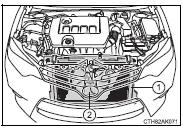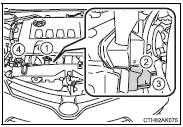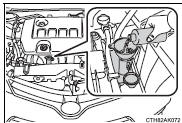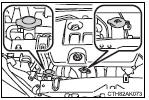Toyota Corolla (E170) 2014–2019 Owners Manual / When trouble arises / Steps to take in an emergency / If your vehicle overheats
Toyota Corolla (E170): If your vehicle overheats
The following may indicate that your vehicle is overheating.
● Vehicles without a multi-information display: The high engine coolant temperature warning light comes on or a loss of power is experienced.
Vehicles with a multi-information display: The engine coolant temperature gauge enters the red zone or a loss of power is experienced.
● Steam comes out from under the hood.
Correction procedures
1 Stop the vehicle in a safe place and turn off the air conditioning system, and then stop the engine.
2 If you see steam:
Carefully lift the hood after the steam subsides.
If you do not see steam: Carefully lift the hood.
3 After the engine has cooled down sufficiently, inspect the hoses and radiator core (radiator) for any leaks.
1 Radiator
2 Cooling fan
If a large amount of coolant leaks, immediately contact your Toyota dealer.

4 The coolant level is satisfactory if it is between the “F” and “L” lines on the reservoir.
1 Reservoir
2 “F” line
3 “L” line
4 Radiator cap

5 Add engine coolant if necessary.
Water can be used in an emergency if engine coolant is unavailable.

6 Start the engine and turn the air conditioning system on to check that the radiator cooling fan operate and to check for coolant leaks from the radiator or hoses.
The fan operates when the air conditioning system is turned on immediately after
a cold start. Confirm that the fan is operating by checking the fan sound and air
flow. If it is difficult to check these, turn the air conditioning system on and
off repeatedly. (The fan may not operate in freezing temperatures.) 7 If the fan
is not operating:
Stop the engine immediately and contact your Toyota dealer.
If the fan is operating: Have the vehicle inspected at the nearest Toyota dealer.
CAUTION
■When inspecting under the hood of your vehicle
Observe the following precautions.
Failure to do so may result in serious injury such as burns.
●If steam is seen coming from under the hood, do not open the hood until the steam has subsided. The engine compartment may be very hot.
●Keep hands and clothing (especially a tie, a scarf or a muffler) away from the fan and belts.
●Do not loosen the radiator cap and the coolant reservoir cap while the engine and radiator are hot.
High temperature steam or coolant could spray out.

NOTICE
■When adding engine coolant
Add coolant slowly after the engine has cooled down sufficiently. Adding cool coolant to a hot engine too quickly can cause damage to the engine.
■To prevent damage to the cooling system
Observe the following precautions: ●Avoid contaminating the coolant with foreign matter (such as sand or dust etc.).
●Do not use any coolant additives.
Other materials:
Deleting call histories
Select “Delete Call History” using
. ● Deleting outgoing call history
1 Select “Outgoing Calls” using .
2 Select the desired phone number using
and press
(YES).
To delete all outgoing call history data, press
(ALL) and then press
(YES).
● Deleting incoming call histo ...
Precaution
1. Handling precautions on srs airbag system
The vehicle is equipped with srs (supplemental restraint system) such as
the driver airbag and front
passenger airbag. Failure to carry out service operation in correct sequence
could cause the srs to
unexpectedly deploy during servicing, po ...
Speedometer sensor (atm)
Replacement
1. Remove air cleaner case
2. Remove air cleaner hose no.1
3. Remove speedometer sensor
disconnect the connector.
remove the bolt and speedometer sensor assembly.
remove the clip and driven gear from the speedometer
sensor.
4. Install speedometer sensor
...


